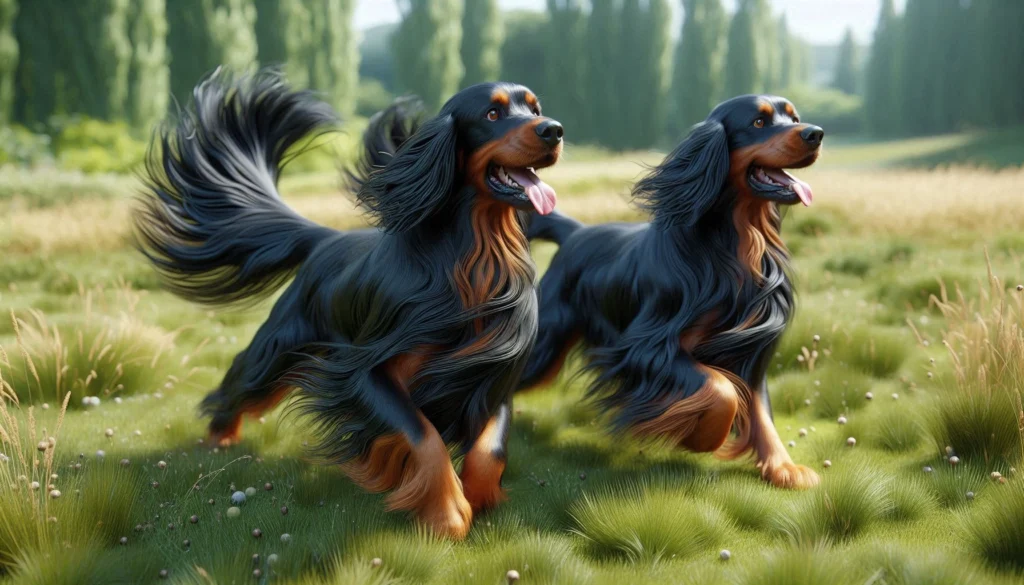Table of Contents
🐶 Gordon Setter Dog Breed: History And Family Suitability
The Gordon Setter, a strikingly beautiful and intelligent dog breed, is known for its distinctive black and tan coat and its excellent hunting abilities. This breed is cherished by dog owners for its loyalty, versatility, and affectionate nature. Whether as a hunting companion, a show dog, or a family pet, the Gordon Setter brings a unique blend of elegance and energy that makes it a popular choice among dog enthusiasts. This article will delve into the history, physical characteristics, temperament, care requirements, and more, providing a thorough understanding of the Gordon Setter.
📜 Short History
The Gordon Setter is a breed with a rich history dating back to 17th century Scotland. The breed was developed primarily by the 4th Duke of Gordon, Alexander Gordon, in the 19th century at his castle in Banffshire, Scotland. The Duke was passionate about hunting, and he sought to create a dog that excelled in the field while also possessing a striking appearance.
Gordon Setters were bred for their stamina and ability to hunt game birds over rough terrain. Unlike other setter breeds, which are generally faster and more agile, the Gordon Setter was bred to be a methodical worker, with a keen sense of smell and an unwavering focus. This made them particularly valuable for hunting in the rugged Scottish Highlands.
An interesting historical fact about the Gordon Setter is that they were originally known as the “Gordon Castle Setters” due to their close association with the Duke of Gordon. The breed gained recognition outside of Scotland in the 19th century and was officially recognized by the American Kennel Club (AKC) in 1884.
🔍 Quick Facts & Essential Details

| Category | Details |
|---|---|
| 🐶 Breed Name | Gordon Setter |
| 🐾 Other Names | Black and Tan Setter |
| 🌍 Origin | Scotland |
| 🏆 Recognized By | American Kennel Club (AKC), Fédération Cynologique Internationale (FCI) |
| 📏 Size Variants | Medium to large |
| ⚖️ Weight Range | 45-80 pounds |
| 📏 Height Range | 23-27 inches |
| ⏳ Lifespan | 10-12 years |
🧥 Coat & Appearance

| Category | Details |
|---|---|
| 🧥 Coat Type | Long, soft, and wavy |
| 🎨 Coat Colors | Black with tan markings |
⚡ Energy & Personality
| Category | Details |
|---|---|
| 🔋 Energy Level | High |
| 🐕 Breed Group | Sporting group |
| 😊 Temperament | Loyal, intelligent, affectionate |
| 🏢 Apartment-Friendly? | Not ideal, needs space to roam |
| 🎓 Trainability | High, but requires patience and consistency |
🏥 Health & Care Needs

| Category | Details |
|---|---|
| 🏥 Common Health Issues | Hip dysplasia, progressive retinal atrophy, bloat |
| 🧼 Grooming Needs | Moderate, regular brushing to prevent matting |
| 🍂 Shedding Level | Moderate |
| 🏃 Exercise Needs | Requires daily vigorous exercise |
🏡 Suitability & Compatibility

| Category | Details |
|---|---|
| 👪 Best For | Active families, hunters, and outdoor enthusiasts |
| 🚫 Not Ideal For | Apartment dwellers or those with limited time for exercise |
| 🗣️ Barking Level | Moderate |
| 👶 Good With Kids? | Yes, generally good with children |
| 🐾 Good With Pets? | Yes, with proper socialization |
| 🆕 First-Time Owner Friendly? | Yes, with commitment to training and exercise |
| 🌡️ Weather Tolerance | Tolerant of various climates, but prefers moderate weather |
🎉 Fun & Extra Info
| Category | Details |
|---|---|
| 🌟 Famous Dogs of This Breed | Featured in various hunting and sporting events |
| 🧠 Intelligence Level | High, excels in obedience and field trials |
| ⚠️ Common Behavioral Issues | Can be stubborn if not exercised enough |
| 🍽️ Best Diet | High-quality dog food formulated for active breeds |
| 🚫 Foods to Avoid | Chocolate, grapes, onions |
| 🎈 Fun Fact | Known for their distinctive black and tan coat, which is unique among setters! |
| 💰 Price of Puppy | $1,000 – $2,500 |
🐶 Gordon Setter VS Similar Dog Breeds



| Breeds Names | 🐶 Gordon Setter | 🐶 Irish Setter | 🐶 Weimaraner |
|---|---|---|---|
| 🌍 Origin | Scotland | Ireland | Germany |
| 🏆 Recognized By | AKC, FCI | AKC, FCI | AKC, FCI |
| 📏 Size Variants | Standard | Standard | Standard |
| ⚖️ Weight Range | 45-80 lbs (20-36 kg) | 60-70 lbs (27-32 kg) | 55-90 lbs (25-41 kg) |
| 📏 Height Range | 23-27 inches (58-69 cm) | 25-27 inches (63-69 cm) | 23-27 inches (58-69 cm) |
| ⏳ Lifespan | 10-12 years | 12-15 years | 10-13 years |
| 🐾 Coat Type | Long, Silky | Long, Silky | Short, Smooth |
| 🎨 Coat Colors | Black & Tan | Red | Silver-Grey |
| ⚡ Energy Level | High | High | High |
| 🐕 Breed Group | Sporting | Sporting | Sporting |
| 📣 Barking Level | Moderate | Moderate | Moderate |
| 👶 Good With Kids? | ✅ Yes | ✅ Yes | ✅ Yes |
| 🐱 Good With Pets? | ✅ Yes | ✅ Yes | ⚠️ Sometimes |
| 🧠 Intelligence Level | High | High | High |
| ⚠️ Common Behavioral Issues | Stubbornness | Stubbornness | Separation Anxiety |
| 💰 Price of Puppy | $1,000-$2,500 | $1,000-$2,500 | $1,200-$2,500 |
| Overall Rating | ⭐⭐⭐⭐ | ⭐⭐⭐⭐ | ⭐⭐⭐⭐ |
Conclusion
The Gordon Setter is a breed that combines beauty, intelligence, and loyalty in a way that few other breeds can. Whether you’re looking for a devoted family pet, an active outdoor companion, or a hunting partner, the Gordon Setter may be the perfect choice. With proper care, training, and attention, this breed can bring years of joy and companionship to your life.
If you’re considering adding a Gordon Setter to your family, take the time to learn more about this remarkable breed. Visit local breeders, attend dog shows, and speak with current owners to find the perfect Gordon Setter for your home.
FAQs
Are Gordon Setters dangerous dogs?
Gordon Setters are not dangerous dogs. They are known for their affectionate and loyal nature. While they may be reserved with strangers, they are typically friendly and gentle with their family members and those they know well. Proper training and socialization are essential to ensure they are well-behaved and confident.
Is the Gordon Setter a good guard dog to protect you or your family?
Gordon Setters can be good watchdogs due to their alertness and protective nature. They are likely to bark to alert their owners of strangers or unusual activity, but they are not typically aggressive. While they may deter intruders with their presence, they are more likely to act as a loyal companion than a traditional guard dog.


